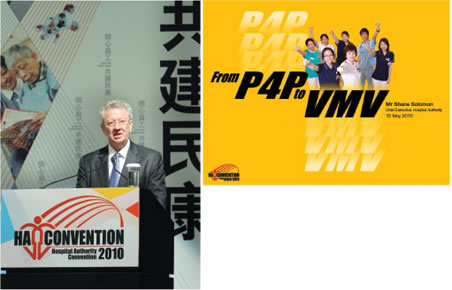
Each year I find the HA Annual Convention an uplifting experience full of life and energy. This year over 3,500 people came along to listen and learn to an impressive group of overseas and local speakers. Like our hospitals, the rooms overflowed with people, but this time with people hungry to hear the pearls of wisdom being imparted.
In itself, the HA Convention reflects our new Vision Mission Values (VMV) statement — happy staff running around showing their commitment and desire to provide a professional service to keep people healthy.
At the Convention, I made a keynote address entitled "From P4P to VMV". As many of you could not be at the opening ceremony, let me share with you here the key parts of what I said.

I first talked about the importance of our new way of allocating our funds, the Pay for Performance (P4P) system. But no matter how well we distribute our resources and reward performance, ultimately what matters is our attitude and behaviour to both the people we serve and our colleagues. That is why the VMV is so important. I have talked about my interpretation of the VMV in these pages before, so will not repeat it here (you can read this part of the speech at ha.home).
I then outlined five action priorities which I think will take us some steps forward towards living the VMV over the next year or two. Supported by our three-year funding agreement with the Government, we are taking forward the following strategic priorities:

For people to be healthy, they must take responsibility for looking after themselves, and not leave it all up to HA colleagues. Our job is to provide them with the resources (advice, treatment, medication, etc.) they need to keep healthy. We call this empowering the patient. If people are taking responsibility for their own health, then less burden falls on HA colleagues, and we may be closer to "happy staff".
This year we have a number of new patient empowerment programmes which will focus first on diabetes and hypertension; ongoing efforts to update our Clinical Management System and develop the Electronic Health Record; the new "Smart Patient" website to give people the information they need to understand their own health and treatments; and further expansion of the Community Health Call Centre in three clusters to help people find the best treatment option for themselves.

To gain the trust of the community and improve people's health, one of our challenges is to reduce waiting times. This will take a multi-pronged effort: extra Government funding and our P4P system to increase the number of patients treated; new service performance pledges for joint replacement and cataract; development of an eReferral system; better support for General Outpatient Clinics; and expansion of public-private partnerships.

Through the sentinel event reporting system we have focused on improving systems and practices to prevent the worst incidents. We are being proactive, and not just constantly reacting to incidents. Besides the initiatives already in place to improve quality, the new ones include filmless radiology to be introduced to more hospitals this year and an Inpatient Medication Order Entry system to commence implementation over the next year. We also are seeking international expert and patient feedback about the quality of our services through the pilot accreditation in five hospitals and an HA-wide Patient Satisfaction Survey.

To achieve "happy staff", workloads have to be manageable. For doctors, we have started to address this through the Doctor Work Reform programme. For nurses, the next step forward is introducing nurse to patient ratios that are reasonable and really put into practice. The key is training more nurses and we are moving from 630 nurses trained three years ago to 1,370 next year, and 2,000 nurses trained in three years. These extra nurses will be allocated to the areas that fall most short of the nurse to patient ratios we desire.

Workload is not just about the number of staff or the number of patients, it is also about how we do our work. I think some of the process re-engineering methodologies have much to offer in designing our work to be smarter and simpler. The New Territories West Cluster has embraced the Japanese Kaizen methodology which uses the "lean thinking" methodology to improve patient experience. The Kowloon Central Cluster is finding ways to simplify and streamline the patient journey. Other clusters are also training people in the "lean thinking" methodology.
The full text of my speech can be found in "CE's Corner" at ha.home. These five action priorities will carry forward the new VMV and make us a truly P2P (people-to-people) organisation. I know all this is a lot of work, but every day I am impressed by the willingness of HA colleagues working as many teams to take up the challenge. I hope these initiatives also help you become "happy staff" as we continue to improve the health service for the Hong Kong community that places their trust in us.
|



